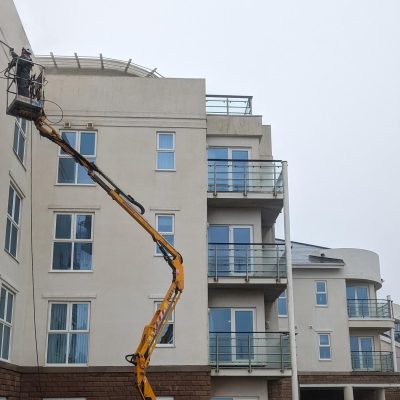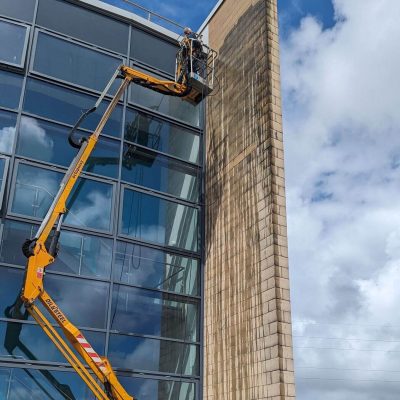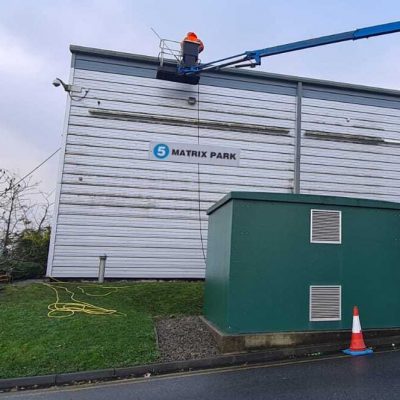Cherry pickers, also known as aerial work platforms or mobile elevated work platforms (MEWPs), have become indispensable tools across Liverpool and Merseyside’s diverse industrial landscape.
For most businesses and contractors in Merseyside, hiring rather than purchasing makes economic sense. The initial investment for buying a cherry picker can range from £15,000 to over £100,000, not including ongoing maintenance, storage, insurance, and certification costs. Hiring provides access to the latest equipment, eliminates storage concerns, and ensures you always have the right machine for each specific job.
This guide covers the Merseyside area (Liverpool, Wirral, Sefton, Knowsley, St Helens) and walks you through choosing the right machine, permits, safety, costs, and how to book with confidence.
What counts as a “cherry picker”? Types of MEWPs you can hire
“Cherry picker” usually refers to boom-type MEWPs that provide outreach (side reach), but people use it generically for several machines. Here’s a quick comparison:
| Type | Also called | Typical working heights | Outreach | Best for |
| Truck-mounted boom | Truck mount, van mount | 20–90 m | Medium–very high | Street works, fast set-up, multiple locations in a day, operated hire |
| Self-propelled articulating boom | Knuckle boom | 12–41 m | Medium–high | Up-and-over access, around facades/obstacles |
| Self-propelled telescopic boom | Straight boom | 20–58 m | High–very high | Long horizontal reach, open sites |
| Spider/tracked boom | Tracked MEWP | 13–42 m | Medium–high | Narrow gateways, delicate floors, indoors/outdoors |
| Trailer-mounted boom | Towable lift | 10–21 m | Low–medium | Light-duty jobs, easy transport |
| Scissor lift | Slab/rough-terrain scissor | 6–18+ m | None | Straight-up work, larger platform area |
Power options:
- Electric: Ideal indoors/low-emission zones; quiet, zero local emissions.
- Diesel: Outdoors, rough terrain; higher duty cycles.
- Hybrid/bi-energy: Diesel + electric flexibility for mixed sites.
- Non-marking tyres and low-noise options exist for indoor or sensitive areas.
How to choose the right machine (step-by-step)
1. Define the task
Working height: The height you need to reach with hand/tools. Working height ≈ platform height + 2 m.
Outreach: Horizontal distance from the centre of the machine to the work point (booms only).
Platform capacity: People + tools. Check SWL (safe working load).
2. Check access constraints
Entrances: Door/gate width/height; many Victorian terraces have tight alleyways and low arches.
Route to work area: Turns, ramps, gradients, manholes, cobbles, paving slabs.
Set-up footprint: Outriggers need extra space (spider/truck mounts).
3. Assess ground conditions
Slabs, cobbles, pavements, grass, basements/voids below.
Ground bearing pressure: You may need spreader/ground mats—especially on pavements or soft ground.
4. Indoor/outdoor and environment
Emissions and noise (residential streets, schools, hospitals).
Tyres: Non-marking for finished floors.
Charging: Ensure power access for electric units; plan charging times.
5. Duty cycle and duration
One-day short job vs multi-day; consider delivery/collection windows and overnight security.
Example local scenarios
Shopfront signage, Bold Street/Lark Lane: Truck-mounted boom with operated hire + traffic management + parking suspension.
Gutter cleaning on a terrace, Anfield/Bootle: Spider boom for narrow access via ginnel/side gate; or small articulating boom if access allows.
Warehouse maintenance, Speke or Knowsley Industrial Park: Electric scissor (vertical work) or articulating boom (over racking).
Tree works, Wirral/Sefton: Tracked spider (low ground pressure) or operated truck mount for roadside trees.
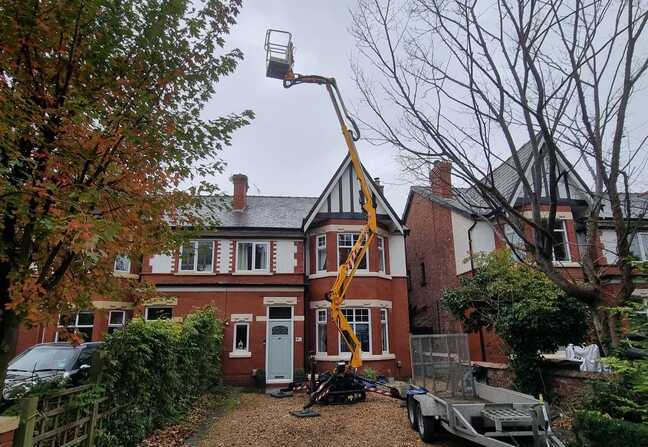
Operator options: operated hire vs self-operated vs self-drive
Operated truck-mount hire
Best when: working on the highway, complex outreach, multiple stops per day, or tight deadlines.
Pros: Professional operator, faster set-up, highway-savvy; often includes cones/barriers (check scope).
Cons: Higher day rate; must book specific time slots.
Self-propelled hire (you supply competent operators)
Best when: inside sites, private land, or where you have IPAF-trained staff.
Training: IPAF PAL card is widely accepted. Common categories:
3a: Mobile Vertical (scissors, vertical lifts)
3b: Mobile Boom (self-propelled boom)
1b: Static Boom (spiders, truck/track mounts, trailer booms)
Self-drive truck-mounts (3.5 t)
Drive on a standard car licence (Category B), but suppliers may set minimum age/experience (often 21–25+).
Check insurance, excess, and any restrictions on nighttime use or long-distance travel.
Safety and compliance
Core regulations
Work at Height Regulations 2005: Plan and perform work safely, avoid height where possible, use the right equipment.
PUWER 1998: Equipment must be suitable and maintained.
LOLER 1998: MEWPs lifting people require a thorough examination every 6 months; ask for current LOLER certs.
RAMS and rescue plan
Prepare a risk assessment and method statement (RAMS).
Have a written rescue plan and someone on site capable of using the ground controls/emergency descent.
Pre-use checks and familiarisation
Daily checks (tyres, hydraulics, controls, alarms, emergency descent).
Familiarisation with the specific model, even if IPAF trained.
Harness policy
Booms (mobile) usually require a full-body harness with a short restraint lanyard attached to the designated anchor to prevent ejection.
Scissor lifts: depends on risk assessment/site rules; not automatically required.
Weather and wind
Respect the manufacturer’s wind rating (many outdoor MEWPs are 12.5 m/s ≈ 28 mph). Some are indoor-only (0 m/s).
Coastal winds in Merseyside can be gusty—use an anemometer and monitor forecasts.
Overhead hazards
Power lines, tree canopies, building projections. Consult the DNO (Distribution Network Operator) before working near overhead lines. As a rule of thumb, do not work anywhere near overhead lines without formal controls agreed by the DNO.
Terrain and stability
Avoid potholes, soft ground, hidden voids; use spreader mats with outriggers.
Respect slope/grade limits.
People/traffic interface
Use a banksman/spotter.
Set exclusion zones and signage. On public highways, Chapter 8-compliant traffic management may be required.
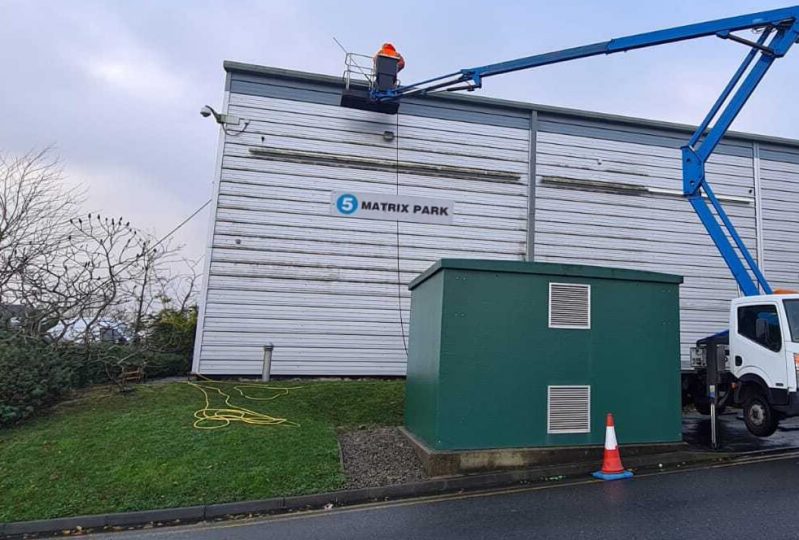
Costs and pricing in Merseyside: what to budget
Indicative ex-VAT ranges (market rates vary by availability, height, and specification):
Self-propelled scissors
- 6–8 m electric (indoor): £70–110/day; £120–180/week
- 10–12 m electric: £90–140/day; £160–240/week
- 13–18 m rough-terrain diesel: £160–260/day; £350–600/week
Self-propelled booms
- 12–17 m electric/diesel: £140–230/day; £300–500/week
- 20–28 m diesel: £180–320/day; £450–750/week
- 30–40 m diesel: £260–450/day; £700–1,000/week
Spider/tracked booms
- 15–25 m: £220–400/day; £550–950/week
- 30 m+: £450–900/day
Trailer-mounted booms
- 12–17 m: £120–200/day; £250–450/week
Truck-mounted (operated)
- 20–33 m: £450–750 per day (or minimum 4–8 hours)
- 35–45 m: £700–1,100 per day
- 50 m+: £1,100–2,000+ per day
- Includes operator; TM/permits charged separately.
Delivery/collection
- Typically £60–150 each way depending on machine size and distance.
Other charges
- Fuel used, cleaning if returned heavily soiled, damage waiver (optional) ~10–15% of hire charges.
- Hired-in plant insurance if you don’t take the damage waiver.
- TM contractor: simple setup £300–600; lane closure/temporary lights £900–2,500+.
- Parking suspensions/bay reservations: roughly £30–90 per bay per day (varies by borough).
- TTRO/road closure: fees plus TM and notice period; often £1,500–3,500+ total.
Example cost scenarios (ballpark, ex-VAT)
City-centre shopfront signage, one day
20–25 m operated truck mount: £550
TM (cones/signs + TM plan): £450
2 x parking bays suspended for 1 day: £120
Total: ~£1,120
Residential guttering, terrace street (2 days)
18–20 m spider boom: £700 (2-day hire rate)
Delivery/collection: £180
Ground mats hire: £40
Total: ~£920
Warehouse maintenance (1 week)
10–12 m electric scissor: £200
Delivery/collection: £120
Charger on site: included
Total: ~£320
Availability and booking timelines
Standard lead times: 1–5 working days for common machines; longer for very tall booms or busy periods.
Permits/TM: apply 1–3 weeks ahead; more for road closures.
Peak periods: spring/autumn maintenance, leaf fall/gutters, pre-Christmas lights, event seasons.
Tips for last-minute hires:
Be flexible on exact height/model.
Consider operated truck mounts for short, urgent street jobs.
Accept out-of-hours deliveries to secure a slot.
Site survey and preparation checklist
Gather this before you request quotes:
Access measurements: Narrowest width/height (mm), turning space, gradient.
Route photos: Entrance, tight turns, surface changes, work area.
Working height and outreach required.
Ground conditions: Slabs, cobbles, basements, soft ground; need for mats.
Overhead hazards: Cables, trees, balconies, canopies.
Power/charging: 110 V/230 V availability for electric machines.
Traffic/parking: Need bay suspension/reservation? School hours, bin days, match days.
Neighbours and noise: Agree times to minimise disruption.
Rescue arrangements: Competent person available for emergency descent.
Common mistakes to avoid
- Confusing platform height with working height: You may come up short—literally.
- Forgetting permits/TM for pavement or road jobs.
- Ignoring wind ratings or ground bearing limits.
- Selecting diesel machines for indoor/LEZ-sensitive sites.
- No rescue plan or second competent person available.
- Underestimating access width/turning space (measure twice, hire once).
- Not allowing time for delivery/collection or bay suspensions before your slot.
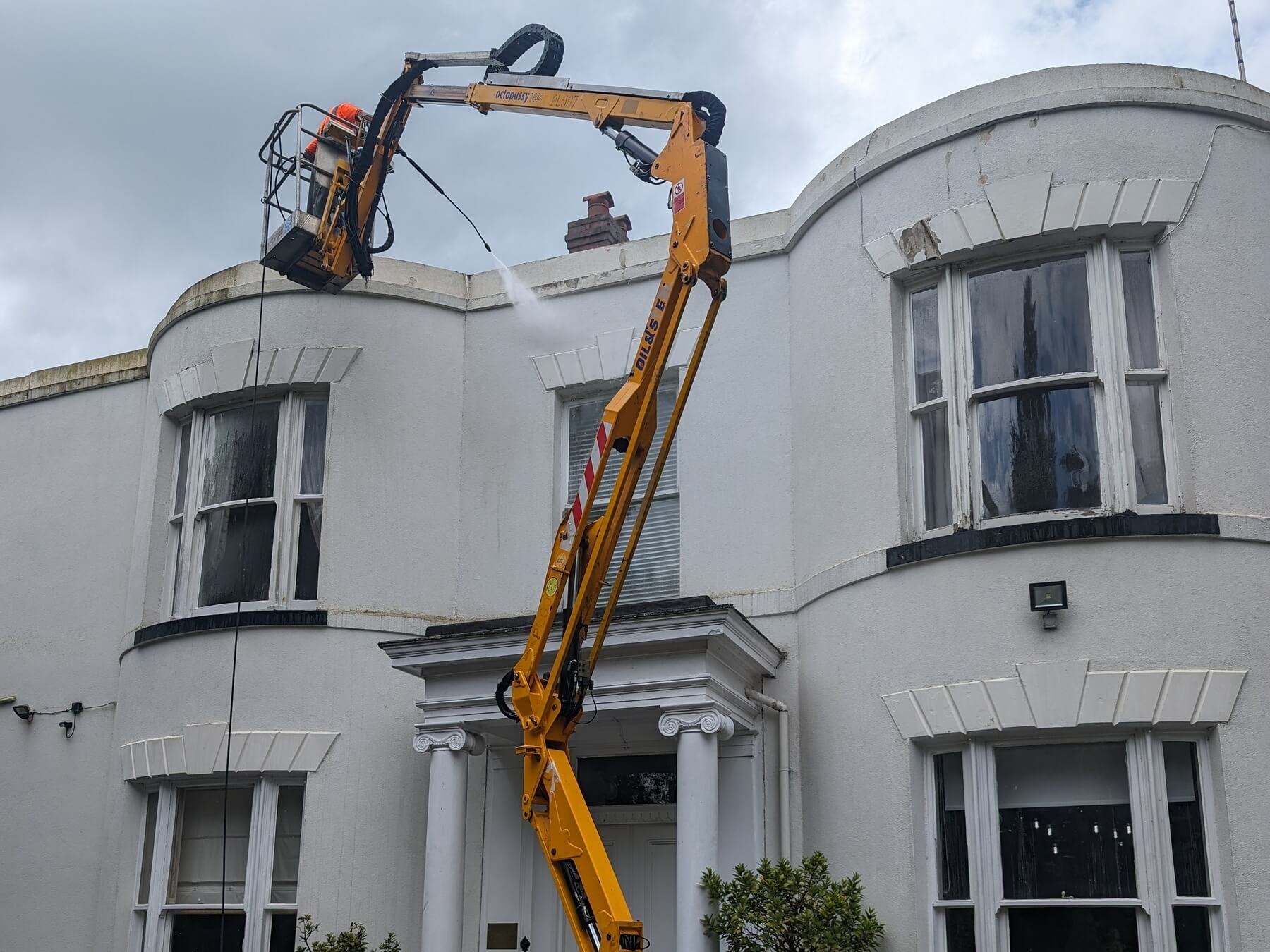
How to choose a reliable local Cherry Picker supplier in Merseyside
- Free or low-cost site surveys (virtual or in-person).
- Rapid breakdown support and modern, well-maintained fleet.
- Clear T&Cs, transparent pricing, and LOLER documentation.
- Permit and traffic management advice or in-house TM service.
Accreditations/memberships
- IPAF member training centre, SSIP (e.g., CHAS/SafeContractor), ISO 9001/14001/45001.
- CPA membership; Access Alliance-style national coverage partners for off-area hires.
FAQs
Do I need a licence to operate a cherry picker?
No special driving licence for self-propelled MEWPs on site. Operators should be trained (IPAF PAL card is widely accepted). Self-drive truck mounts up to 3.5 t can be driven on a Category B licence; check supplier age/insurance rules.
Can I put a cherry picker on a pavement?
Not without permission. You’ll need a licence/permit from the local highway authority and likely a TM plan. Pavements often need spreader mats to protect slabs and utilities.
How much is a day for cherry picker hire in Liverpool?
Small electric scissors from ~£70–110/day; 20–25 m booms ~£180–320/day; operated truck mounts 20–33 m ~£450–750/day. Ex-VAT; delivery, permits, and TM are extra.
Can I work in wind/rain?
Yes in light rain, but stop if wind exceeds the machine’s rated limit. Some units are indoor-only (0 m/s wind rating).
What hours can I operate in residential areas?
Commonly 8am–6pm weekdays, shorter hours on Saturdays, and restrictions Sundays/bank holidays. Confirm locally and check event calendars.
How close can I go to power lines?
Keep well clear and consult SP Energy Networks for safe distances and controls. Do not rely on guesswork.
How quickly can you deliver?
Often same/next day for standard machines if permits aren’t needed. Street works depend on permit/TM lead times.
Do I need a harness?
On booms: yes, typically a full-body harness with restraint lanyard. On scissors: follow your risk assessment and site policy.
What if my street is too narrow?
Consider a spider boom through a side gate or rear access, or an operated truck mount with compact footprint and TM to occupy the carriageway.
Glossary
- Working height: Platform height + approx. 2 m to your hands.
- Outreach: Horizontal reach of a boom beyond the machine’s base.
- SWL: Safe Working Load (max people + tools weight).
- Outrigger/spreader mats: Supports that stabilise machines; mats spread load on weak ground.
- IPAF PAL card: Proof of operator training/competence.
- Chapter 8: UK guidance for signing, lighting, and guarding at roadworks.
- TTRO: Temporary Traffic Regulation Order (legal order for road closures/changes).
- CPA conditions: Standard UK hire conditions from the Construction Plant-hire Association.
At Garna, we’ve supplied cherry pickers and MEWPs across Merseyside for over 10 years. To get the most from your hire, match the kit to the task (height, outreach, capacity), plan for access and ground bearing, and keep safety central with IPAF‑trained operators, RAMS, and a rescue plan. If your work touches the pavement or road, factor in permits and traffic management early. And if you need help, share measurements/photos and we’ll advise.

